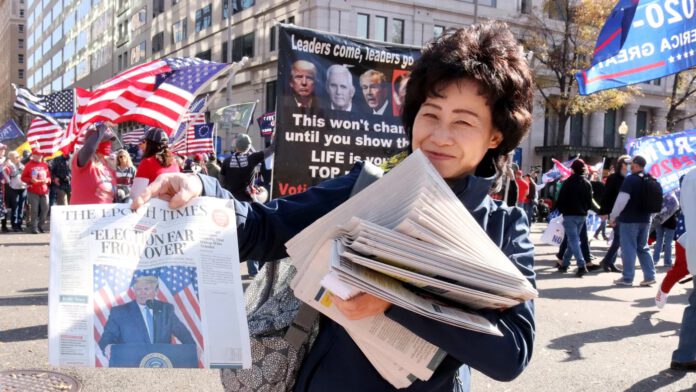
The New York Times recycled flimsy claims by a right-wing apocalyptic extremist to accuse China of “genocide,” in an op-ed by an American with 1/8th Uighur heritage who worked for Epoch Times, a far-right, pro-Trump outlet backed by cult Falun Gong.
The New York Times published a factually challenged op-ed accusing China of committing “genocide” against its Uighur minority. The article sourced its spurious accusations to a right-wing operative who insists his research is part of a divine “mission” against Beijing that is “led by God.”
The author of the New York Times op-ed, Amelia Pang, happens to be a former employee of the Epoch Times, a far-right propaganda arm of a fanatical anti-China cult called Falun Gong. The extremist group preaches that race-mixing, homosexuality, feminism, and science are Satanic plots, and reveres Donald Trump as a God-like figure who was sent down from heaven to destroy the Communist Party of China.
In a statement to The Grayzone, Pang said, “The Epoch Times and the Falun Gong group do not represent my views in any way.”
However, a review of her five years of work at the Epoch Times shows Pang churned out hyperbolic anti-China reporting while publishing at least 17 articles promoting the Falun Gong cult or its cultural front group, Shen Yun.
The New York Times’ decision to run Pang’s commentary was ironic in light of the lengthy feature it published on the Falun Gong propaganda arm in October 2020, which branded the Epoch Times a “leading purveyor of right-wing misinformation” that is “pushing dangerous conspiracy theories” with a “willingness to feed the online fever swamps of the far right,” and a “growing influence in Mr. Trump’s inner circle.”
In her Times op-ed, Pang deployed her 1/8th Uighur heritage to portray herself and her family as victims of a purported “genocide” carried out by the Chinese government. At the same time, she acknowledged that she has lived her entire life in the United States, and therefore has little familiarity with China and its society.
Pang’s op-ed ran just days before the Trump administration formally accused Beijing of genocide. US Secretary of State Mike Pompeo, a far-right rapture-ready evangelical, alleged that China “has committed genocide against the predominantly Muslim Uyghurs and other ethnic and religious minority groups in Xinjiang.”
The Pompeo State Department provided no evidence to bolster its extreme accusations, yet alleged that China’s campaign of “genocide” began in March 2017.
The Grayzone has reported extensively on the Western disinformation campaign against China, chronicling how discrimination against the Uighurs and other minorities have been spun into accusations of genocide, including claims of “concentration camps” holding millions of detainees. In nearly every case, incendiary corporate media and State Department claims related to the issue rely on questionable research by a single far-right operative with extremist views and a network of anti-China NGOs funded by the US government and the arms industry.
The New York Times has been a central conveyor belt for the transmission of the US information war against China, providing it with a critical patina of journalistic credibility and marketing it to the liberal intelligensia that comprises the Times’ readership.
Former Epoch Times reporter relies on far-right operative in New York Times
The New York Times printed Pang’s op-ed, “It Took a Genocide for Me to Remember My Uighur Roots,” on January 10. The faulty article was a case study in how little evidence corporate media editors require to green light a piece as long as it accuses official US enemies of the most titanic of war crimes.
The Times translated the op-ed from English into both simplified and traditional Chinese so it could be read around the world.
In the article, Pang acknowledged, “I have lived in the United States my entire life,” and “no one [in my family] had ever visited Xinjiang apart from my mother and one aunt, and neither of them had stayed in touch with the relatives they met.”
But she wrote, “my maternal grandmother was half Uighur” – or, her great-grandmother was Uighur, which made her 1/8th Uighur. And in the hyper-identitarian neoliberal culture that now dominates the New York Times newsroom, this was enough to confer unassailable authority upon the author.
Despite her distant connection to China, Pang characterized herself and her family as victims of the Chinese communist party. “China’s forced assimilation policies still reached me,” she wrote, attributing her total lack of knowledge of Uighur culture not to her family’s fairly typical story of assimilation as American immigrants, but rather to Beijing’s supposed cruelty.
“I’m sorry it took a genocide for me to remember I am Uighur,” Pang tweeted.
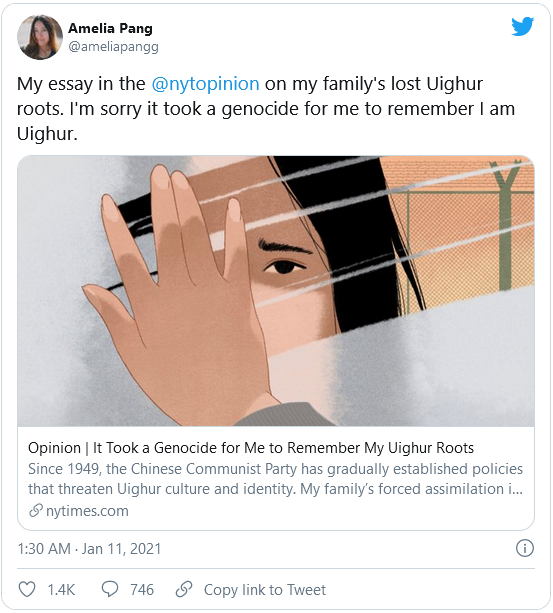
It is notable that the Times was so willing to entertain the accusatory angst of a US pundit with 1/8th Uighur heritage, while it actively ignores and silences the many Uighurs born and raised in China’s Xinjiang province, who support the Communist Party of China and the government’s developmental policies. The de facto policy is similar to its disportionate reliance on quotes from liberal and Islamist exiles from Syria while refusing to quote members of the country’s loyalist majority living inside Syria.
Meanwhile, social media platforms like Twitter and Facebook have suspended the accounts of prominent Uighurs and other Chinese Muslims who provided an alternative perspective on the conflict. In Western media, only one viewpoint is allowed: that which serves the interest of Washington and its new Cold War.
Pang’s Times article was also significant in the political marker it established: It allowed the newspaper of record to accuse Beijing of genocide, echoing the US government, while maintaining a veneer of independence by doing so through an op-ed.
In her article, Pang moved well beyond criticizing Chinese discrimination against the minority Uighur community and the government’s heavy-handed approach to combating Islamist extremist separatist groups in the region, who have carried out a wave of terrorist attacks targeting both government targets and civilians.
To make her case that the Chinese government was guilty of “genocide,” Pang misleadingly implied that the United Nations has accused China of the crime – a disinformation tactic that has become common in anti-China reporting in the Western media. But the UN has not done so.
“In recent years, identifying as Uighur has become a matter of life and death,” Pang wrote. “What started as a cultural genocide has progressed into a literal one, as defined by the United Nations.”
In this deceptively worded line, Pang linked to an article by US government-funded broadcaster NPR, titled “China Suppression Of Uighur Minorities Meets U.N. Definition Of Genocide, Report Says.” This article is also misleading.
The report both Pang and NPR were citing was not a United Nations document, but rather an investigation by a far-right German academic named Adrian Zenz.
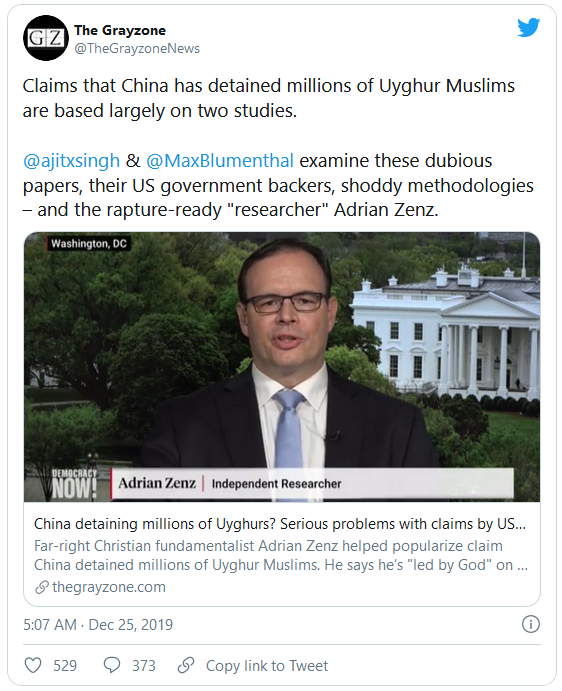
Zenz even told the Wall Street Journal that his highly questionable work on Xinjiang is “like a mission, or a ministry” for him. That is to say, his research is explicitly motivated by his ideology, the precise opposite of social science.
The far-right German academic is the source for practically every Western media report alleging “genocide” and enormous concentration camps in Xinjiang. Zenz, who has not spent a significant period of time in China, and has no evident scholarly expertise on Chinese politics, history, or society, is not so much an academic as he is a right-wing operative.
Zenz has also found time to volunteer his belief that God’s apocalyptic Rapture will soon come, and Jews who refuse to convert to Christianity will, in his words, be “wiped out” and shoved in a “fiery furnace,” as journalist Dan Cohen reported.
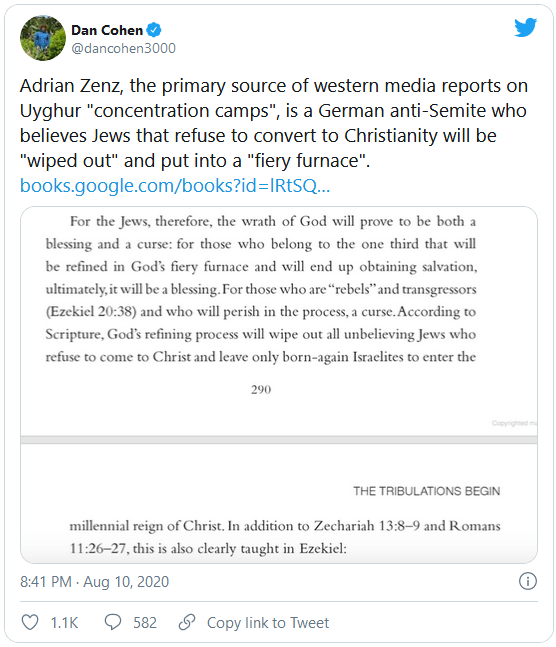
Adrian Zenz works for the Victims of Communism Memorial Foundation, a right-wing lobby group that was founded by the US government and is linked closely to the Republican Party. His research on Xinjiang is clearly politically motivated by his explicit desire to demonize the Chinese government and eventually overthrow the communist party.
Correspondingly, The Grayzone has documented how Zenz’s methodology in his reports on Xinjiang is comically shoddy, filled with gaping factual flaws and logical leaps that would not withstand the scrutiny of impartial academic experts.
As Ajit Singh and Max Blumenthal reported for The Grayzone, Zenz’s estimate that “over 1 million” Muslim minorities are held in “concentration camps” in Xinjiang was based on a lone report by Istiqlal TV, an Islamist media outlet run by Uyghur separatists based in Turkey. The outlet provides a friendly platform for extremist supporters of the East Turkestan Islamic Movement (ETIM), a separatist group that seeks to build an Islamic state in Xinjiang, which it calls East Turkestan.
ETIM, also known as the Turkistan Islamic Party (TIP), is an al-Qaeda-linked extremist militia that has carried out numerous terrorist attacks in Xinjiang. It is recognized as a terrorist organization by the United Nations, European Union, and many countries. Pompeo’s State Department removed ETIM from the US government’s official terrorist list in October 2020, as part of Washington’s intensifying cold war on China.
Despite the massive and well-documented flaws in Zenz’s research, Amelia Pang cited him by name in her Times op-ed, echoing his work to accuse China of overseeing a massive increase in “forced sterilizations” in Xinjiang.
In her article, Pang referred to Zenz simply as “an expert on China’s ethnic policies,” conveniently overlooking his extreme-right political views and his work for a US government-linked right-wing lobby group.
Despite his widespread portrayal as an “expert,” it is not clear if Zenz even speaks Mandarin Chinese or Uighur. The academic has not done any public events showing proficiency in either language. When journalists from The Grayzone asked Zenz about his qualifications, he blocked them on social media.
Misleadingly distorting China’s anti-extremism re-education centers
From the very first line, Amelia Pang’s New York Times op-ed was based on distortions. She wrote, “The first time I truly realized I was Uighur was just three years ago, when I saw the now-infamous viral photo of rows of Turkic men in dark blue uniforms, sitting in a concentration camp in Hotan, Xinjiang, a so-called Uighur autonomous region in China.”
The photo Pang referenced has been heavily circulated by Western media outlets and NGOs, and is upheld as practically the only image proving the existence of “concentration camps” run by Beijing. This characterization is however deeply misleading.
The photo was not taken by some courageous prisoner or crusading investigative journalist; it was published by the Chinese government itself, in a press release from 2014 — three years before the State Department claimed the “genocide” began in Xinjiang.
In fact, the original image was published on the Xinjiang Bureau of Justice’s own WeChat account, with a watermark identifying it as an official photo taken by Chinese authorities. Western anti-China propagandists have subsequently cropped off the watermark and presented the photo as proof of China caught in the act.

The photo shows a de-radicalization program at a Chinese detention center in Luopu County, Xinjiang on April 7, 2014.
The Chinese government press release said the event featured talks from local Muslim leaders and presentations focused on “social stability” and “long-term peace” which “clearly clarified the traditional teachings and rules of Islam and righteousness; clarified the serious harm of religious extremism and violent terrorist activities; clarified the importance of the unity and struggle of all ethnic groups in Xinjiang for common prosperity and development; clarified the importance of Xinjiang’s development.”
Other photos taken at the same 2014 anti-extremist event in Xinjiang have never been shared in Western media reports, and for obvious reasons: they depict innocuous scenes that stand at odds with the official US government portrayal.

While the Chinese government has challenged hyperbolic accusations of running “concentration camps,” it has openly admitted to operating de-radicalization centers for Islamist extremists – members of the same separatist organizations that have carried out scores of mass casualty attacks in the Xinjiang region, killing state officials and civilians alike.
It is certainly fair to characterize the tactics used in the Chinese government’s crackdown on extremism and separatism in Xinjiang as heavy-handed, and even repressive, but the reality is a far cry from a campaign of “genocide.”
The term “concentration camp” in Western anti-China propaganda is clearly meant to invoke the mass extermination that took place in Nazi death camps. Washington’s goal is to depict Beijing as a Nazi-like government, in order to justify aggressive US actions against the country and an eventual push for regime change.
The highly suspect research from anti-China activists like Adrian Zenz have absurdly exaggerated the number of people who have passed through these re-education centers. The bottom-feeding pundits desperate to validate Zenz’s shoddy research have resorted to cartoonishly preposterous propaganda that portrays the situation as worse than the Nazi Holocaust.
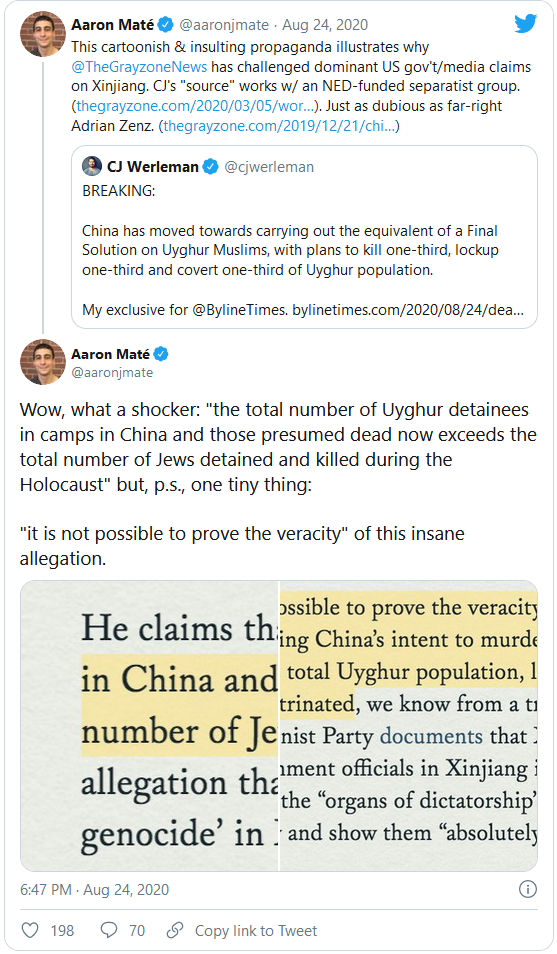
Before the US initiated its new Cold War with China, Western corporate media outlets openly acknowledged that China faced a major national security threat in Xinjiang in the form of a Wahhabist separatist movement determined to destabilize the entire region and ultimately break away.
In a 2017 report titled “Uighurs fighting in Syria take aim at China,” the Associated Press reported, “Since 2013, thousands of Uighurs, a Turkic-speaking Muslim minority from western China, have traveled to Syria to train with the Uighur militant group Turkistan Islamic Party and fight alongside al-Qaida, playing key roles in several battles.”
The AP continued: “Uighur militants have killed hundreds, if not thousands, in attacks inside China in a decades-long insurgency that initially targeted police and other symbols of Chinese authority but in recent years also included civilians.”
The outlet quoted a Uighur militant who said his group traveled to Syria “to learn how to use the weapons and then go back to China.” Another extremist said they were basing their movement on Zionism, and hoped to create an Islamist version of Israel in modern-day Xinjiang.
“The end of Syria’s war may be the beginning of China’s worst fears,” the AP wrote.

While Washington has preferred killing Islamist extremists like these with drones and military interventions, China has resorted to re-education centers.
For Beijing, the Xinjiang region is extremely important. It is a key geo-strategic location that lies at the heart of the New Silk Road that will provide an economic bridge between China and Central Asia.
Washington has made it clear that it wants to sabotage Beijing’s Belt and Road Initiative, an ambitious plan to link Global South nations and recenter Asia in the global economy.
And the United States knows it can throw a massive wrench in China’s plans by encouraging separatist movements in Xinjiang.
This is precisely why Washington’s regime-change arm the National Endowment for Democracy (NED), a CIA cutout established by the Ronald Reagan administration at the end of the first Cold War, has poured millions of dollars into Uighur separatist groups.
The NED publicly boasted of its support for the Uighur separatist movement on Twitter in December 2020.
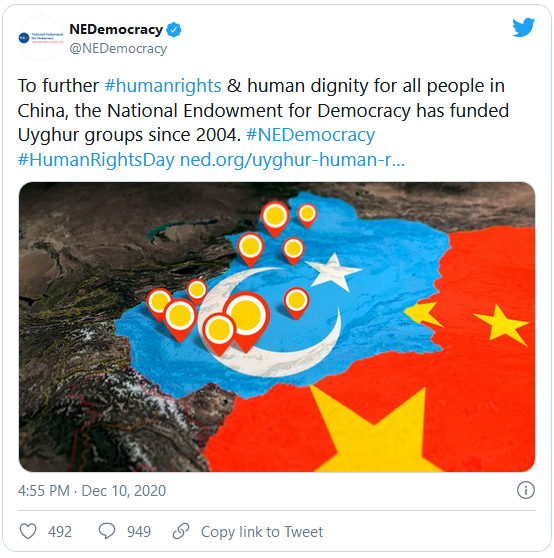
The accusations of genocide and concentration camps in China also fail to take into account a global perspective. The United States has less than 5 percent of the planet’s population, but nearly 25 percent of its prisoners.
In the American system of mass incarceration, detainees are often imprisoned with draconian sentences based on preposterous, unfounded charges, where they are held in miserable, torturous conditions. Slave labor is also widespread in the US prison system, and a hugely disproportionate percentage of those prisoners are Black, Latino, and Indigenous.
But few countries would formally accuse the United States of committing genocide against minority groups — and if they did, mainstream Western journalists certainly would not eagerly echo their claims. But when the accusations are made against China, pundits like Pang can reap endless mainstream media opportunities by amplifying them or filtering them through their personal narrative.
Careerism in the new Cold War
Amelia Pang is the author of “Made in China: A Prisoner, an SOS Letter, and the Hidden Cost of America’s Cheap Goods,” a book advancing the forced labor allegations made against China by the US State Department.
Though she presents herself as a liberal, Pang supported the Trump administration’s economic attacks on the Chinese government, clamoring for the most aggressive measures available.
In January, the Trump administration announced strict trade policies banning the import of cotton and tomatoes from China’s Xinjiang province, the autonomous region where most Uighurs live.
The right-wing Victims of Communism Memorial Foundation, which employs Adrian Zenz and has extensive links to the US government, claimed credit for helping to advancing the new policy.
Pang took to Twitter to praise the Trump administration’s economic restrictions.
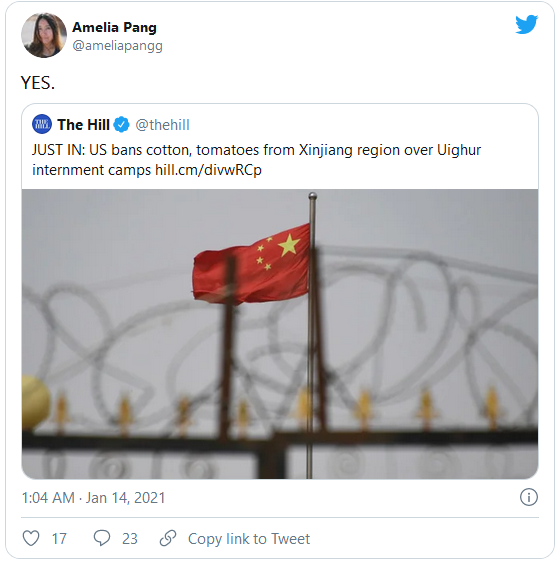
When Pang published her op-ed with the New York Times, the newspaper of record curiously omitted her five years of work for the Epoch Times from her bio.
Pang’s publicly available LinkedIn profile shows that she worked for the propaganda arm of the Falun Gong cult between 2011 and 2016.

Ironically, the New York Times’ reporting on the Epoch Times acknowledged that many of Falun Gong’s “strident accounts of persecution in China can sometimes be difficult to substantiate or veer into exaggeration.”
The New York Times referred to the Epoch Times as a “global-scale misinformation machine that has repeatedly pushed fringe narratives into the mainstream,” noting that the Falun Gong propaganda outlet has even promoted the outlandish QAnon conspiracy theory.
Pang frequently reported on China-related issues for the Epoch Times. Some of her articles included blatant PR for Falun Gong, with titles like “Listen: Musicians From Sweden to Mexico Sing for Falun Gong.”

Pang’s anti-China Epoch Times reports go all the way back to 2011, when she amplified Falun Gong protests and described China’s National Day, the anniversary of the founding of the People’s Republic, as a “National Tragedy Day to rebuff the Communist Party and its history of violence and atrocity.”
Pang also wrote at least 12 PR pieces openly promoting Shen Yun, a dance form that is used as a cultural front for the Falun Gong cult. In one, she quoted an Obama White House staff member who called it the “best show around the world.”

Pang also churned out a puff piece on anti-China separatist leader Rebiya Kadeer, the multimillionaire Uighur oligarch who, from inside the United States, previously ran the right-wing group the World Uyghur Congress, which is funded by the US government’s NED regime-change arm.
In the fawning profile, Pang herozied Kadeer as the “Dalai Lama of Xinjiang.” Noting that Kadeer was “China’s Richest Woman” and “the seventh richest person in China at the time,” Pang touted the Uyghur separatist leader as “one of the Chinese Communist Party’s top public enemies.”
Not only was Pang aware of the US government funding for Kadeer’s separatist activities, she celebrated it in the article. “Remarkably, Kadeer has managed to get funding from the National Endowment for Democracy and private donors for the two organizations she heads, the Uyghur American Association and the World Uyghur Congress,” Pang wrote.
Pang also noted how, in a private meeting with George W. Bush in 2007, the US president praised Kadeer as “far more valuable than the weapons of [China’s] army or oil under the ground.”

In this Epoch Times puff piece, Pang went so far as to accuse China of “harvesting the organs of live Uyghur prisoners.”
As her source for the accusation, Pang cited a book by Ethan Gutmann, an eccentric American anti-China activist who has testified for the CIA, US Congress, and Knesset. His research has been funded in part by the NED.
Gutmann also worked for neoconservative think tanks like the Project for the New American Century (PNAC) and Foundation for Defense of Democracies (FDD), key institutional forces behind the Iraq War and the push for a war on Iran. Gutmann’s highly ideological research, which is often based on little more than rumors, was called into question even by the former mayor of Taipei, Taiwan, Beijing’s principal political rival.
Pang also noted in her Epoch Times article that Xinjiang is geo-strategically important for China. “Xinjiang is four times the size of California; most important, it has an oil-rich region that is the size of France. Its land is also rich with minerals and natural gas,” she wrote.
She added ominously, “it would be in the Chinese regime’s best interest to reach an accord with the Uyghurs… Xinjiang is a critical place for China’s development in the coming years. Riots and unrests are not attractive to investors.”
The Grayzone contacted Amelia Pang with a request for comment, inquiring if she was aware of the Epoch Times’ close relationship with Falun Gong and if she has had any affiliation with the cult. She replied with just one line: “The Epoch Times and the Falun Gong group do not represent my views in any way.”
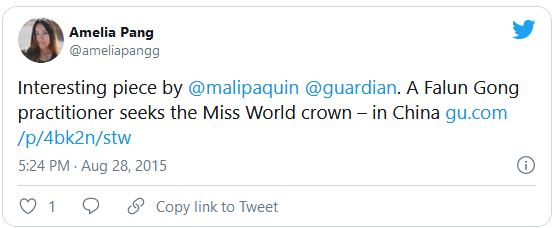
Anti-China book promoted by influential US regime-change activist
At the top of her personal website, Amelia Pang advertises her book, “Made in China: A Prisoner, an SOS Letter, and the Hidden Cost of America’s Cheap Goods,” which is due in February 2021.
The book’s homepage highlights a blurb written by Orville Schell, the director of the Center on U.S.-China Relations at the Asia Society, an influential NGO funded by the Rockefeller Foundation and other foundations with historic links to the US intelligence apparatus.
Schell also has an eyebrow-raising record of work at the Ford Foundation, a CIA cut-out, in Indonesia from 1964 to 1966, at precisely the time when the country’s US-backed military dictatorship was enacting an actual genocide. With help from the CIA, Indonesia’s dictator Suharto murdered between 1 and 3 million communists, left-wing sympathizers, labor organizers, and ethnic Chinese people, in what the CIA privately admitted was “one of the worst mass murders of the 20th century,” alongside the Nazi Holocaust.
Schell undertook his Ford Foundation fellowship in Jakarta when he was a graduate student at the University of California, Berkeley – the same institution where an infamous group of Indonesian economists known as the “Berkeley Mafia” were trained with Ford Foundation funding in the capitalist shock therapy they imposed on Indonesia’s formerly socialist-oriented economy.
The endorsement of Pang’s book by a figure like Schell highlights the usefulness of her writing to Western foreign policy elites. Her work was so useful, in fact, that her many years of employment by a far-right publicity arm for an anti-China cult that even the New York Times has lambasted was apparently necessary to conceal.
Autor: Ben Norton is a journalist, writer, and filmmaker. He is the assistant editor of The Grayzone, and the producer of the Moderate Rebels podcast, which he co-hosts with editor Max Blumenthal. His website is BenNorton.com and he tweets at @BenjaminNorton.
(Source: Ny Times Uighur-china-genocide-falun-gong – TheGrayZone)



